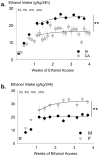Persistent escalation of alcohol drinking in C57BL/6J mice with intermittent access to 20% ethanol
- PMID: 21631540
- PMCID: PMC3166538
- DOI: 10.1111/j.1530-0277.2011.01545.x
Persistent escalation of alcohol drinking in C57BL/6J mice with intermittent access to 20% ethanol
Abstract
Background: Intermittent access (IA) to drugs of abuse, as opposed to continuous access, is hypothesized to induce a kindling-type transition from moderate to escalated use, leading to dependence. Intermittent 24-hour cycles of ethanol access and deprivation can generate high levels of voluntary ethanol drinking in rats.
Methods: The current study uses C57BL/6J mice (B6) in an IA to 20% ethanol protocol to escalate ethanol drinking levels. Adult male and female B6 mice were given IA to 20% ethanol on alternating days of the week with water available ad libitum. Ethanol consumption during the initial 2 hours of access was compared with a short-term, limited access "binge" drinking procedure, similar to drinking-in-the-dark (DID). B6 mice were also assessed for ethanol dependence with handling-induced convulsion, a reliable measure of withdrawal severity.
Results: After 3 weeks, male mice given IA to ethanol achieved high stable levels of ethanol drinking in excess of 20 g/kg/24 h, reaching above 100 mg/dl blood ethanol concentrations, and showed a significantly higher ethanol preference than mice given continuous access to ethanol. Also, mice given IA drank about twice as much as DID mice in the initial 2-hour access period. B6 mice that underwent the IA protocol for longer periods of time displayed more severe signs of alcohol withdrawal. Additionally, female B6 mice were given IA to ethanol and drank significantly more than males (ca. 30 g/kg/24 h).
Discussion: The IA method in B6 mice is advantageous because it induces escalated, voluntary, and preferential per os ethanol intake, behavior that may mimic a cardinal feature of human alcohol dependence, though the exact nature and site of ethanol acting in the brain and blood as a result of IA has yet to be determined.
Copyright © 2011 by the Research Society on Alcoholism.
Figures




References
-
- Baldwin HA, Rassnick S, Rivier J, Koob GF, Britton KT. CRF antagonist reverses the “anxiogenic” response to ethanol withdrawal in the rat. Psychopharmacology. 1991;103:227–232. - PubMed
-
- Ballenger JC, Post RM. Kindling as a model for alcohol withdrawal syndromes. Br J Psychiatry. 1978;133:1–14. - PubMed
-
- Barros H, Miczek KA. Withdrawal from oral cocaine in rats:ultrasonic vocalizations and tactile startle. Psychopharmacology. 1996;125:379–384. - PubMed
-
- Becker HC, Hale RL. Repeated episodes of ethanol withdrawal potentiate the severity of subsequent withdrawal seizures: an animal model of alcohol withdrawal “kindling”. Alcohol Clin Exp Res. 1993;17:94–98. - PubMed
Publication types
MeSH terms
Substances
Grants and funding
LinkOut - more resources
Full Text Sources
Other Literature Sources
Medical

